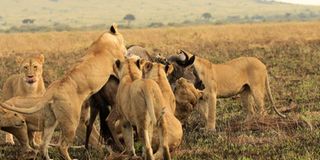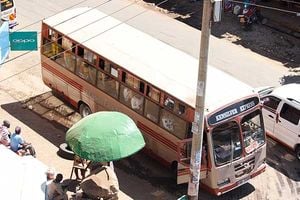Only a total ban on wildlife trade can save our dying lion population, says lobby

A pride of lions kill a wildebeest at Sopa area in Maasai Mara game reserve. According to the animal welfare group, approximately 200,000 lions roamed the continent about 100 years ago.
The number of lions is declining at an alarming rate across the world aided by wildlife trade, a lobby has warned.
The true cost of wildlife trade, according to global animal welfare group, World Animal Protection (Wap), is not only limited to the shrinking numbers but also extends to animal suffering, widespread ecosystem damage and emergence of pandemics.
Wap raised the concerns when they launched a global digital campaign to end wildlife trade. The campaign seeks to pile pressure especially on South Africa and other Group of Twenty (G20) countries to commit to a ban on global wildlife trade.
The campaign comes in the wake of more incriminating indications that the currently devastating Covid-19 pandemic could have originated from animal trade.
Data from the organisation indicate that an estimated 8,000-12,000 African lions are languishing in breeding farms and captivity facilities in South Africa.
While the country has the largest number of lions in Africa, it is not all for good reasons as those kept in breeding farms are often destined to be slaughtered for their products used in making traditional Asian medicine.
Between 2007 and 2016, South Africa was the main exporter of lion products with smaller amounts reportedly coming from Zimbabwe, Tanzania, Namibia, Zambia among others.
Extinction risk
“The leaders of the world’s 20 largest economies can bring about a collective response and global answers to the Covid-19 and future pandemics. We can no longer afford to leave this to chance. A global wildlife trade ban is the only way to end the cruelty and protect our health and economies,” said the Campaigns Manager at Wap, Edith Kabesiime.
She said animals like lions are at the centre of a cruel multi-billion-dollar business that exploits them on an industrial scale. “They are shipped around as freight, treated as mere commodities, with their wellbeing ignored; crammed in cages, kept in poor health, and eventually killed for their body parts,” she added.
According to the animal welfare group, approximately 200,000 lions roamed the continent about 100 years ago.
Currently, however, they are largely only found in parts of Sub-Saharan Africa and they number fewer than 25,000 wild lions – and possibly less than 40,000 in the whole world, according to Wap findings.
The International Union for Conservation of Nature has consequently classified lions as vulnerable to extinction.



